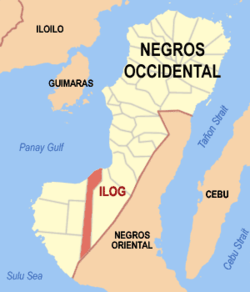Ilog | |
|---|---|
| Municipality of Ilog | |
 Map of Negros Occidental with Ilog highlighted | |
Location within the Philippines | |
| Coordinates: 10°02′N122°46′E / 10.03°N 122.77°E | |
| Country | Philippines |
| Region | Negros Island Region |
| Province | Negros Occidental |
| District | 6th district |
| Founded | May 16, 1584 |
| Barangays | 15 (see Barangays) |
| Government | |
| • Type | Sangguniang Bayan |
| • Mayor | John Paul K. Alvarez (NPC) |
| • Vice Mayor | John Paulo M. Alvarez (NPC) |
| • Representative | Mercedes Alvarez (NPC) |
| • Municipal Council | Members |
| • Electorate | 35,498 voters (2025) |
| Area | |
• Total | 281.70 km2 (108.76 sq mi) |
| Elevation | 191 m (627 ft) |
| Highest elevation | 1,438 m (4,718 ft) |
| Lowest elevation | 0 m (0 ft) |
| Population (2024 census) [3] | |
• Total | 63,444 |
| • Density | 225.22/km2 (583.31/sq mi) |
| • Households | 14,097 |
| Economy | |
| • Income class | 1st municipal income class |
| • Poverty incidence | 28.22 |
| • Revenue | ₱ 296.1 million (2022) |
| • Assets | ₱ 762.7 million (2022) |
| • Expenditure | ₱ 300.3 million (2022) |
| • Liabilities | ₱ 341.7 million (2022) |
| Service provider | |
| • Electricity | Negros Occidental Electric Cooperative (NOCECO) |
| Time zone | UTC+8 (PST) |
| ZIP code | 6109 |
| PSGC | |
| IDD : area code | +63 (0)34 |
| Native languages | Hiligaynon Tagalog |
Ilog, officially the Municipality of Ilog, is a municipality in the province of Negros Occidental, Philippines. According to the 2024 census, it has a population of 63,444 people. [5]




